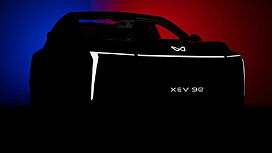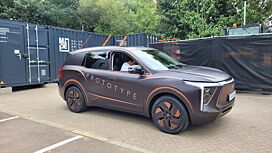What is it?

If the idea of a performance-focussed yet affordable hatch appeals to you, there are hardly any other options than the new Maruti Suzuki Baleno RS. But what does the RS do that its arch rivals (including the brilliant VW Polo GT TSI and the charming Punto Abarth) don’t?

For starters, Maruti has positioned the Baleno RS rather cleverly in a segment which is gaining traction slowly and steadily. So while it doesn’t have the clever drivetrain of the GT TSI or the unmistakable flair of the Punto Abarth, the Baleno RS costs noticeably less than either and offers plenty of grunt for the grown-up enthusiast looking for a discreet performance hatch with relatively humble roots.

The Baleno RS is the textbook definition of ‘understated’ as far as the exterior design goes. In terms of cosmetic add-ons or upgrades over the standard car, there’s nothing major to report – upfront there’s a slightly different grille and at the back you will find a racier-looking rear bumper and the RS emblem. The alloy wheels, too, come from the standard car but are finished in gloss black for a meaner stance. Lastly, there’s the tastefully executed body kit (including the front lip, side and rear skirts) which goes great with the dark blue paint on our test car.
How is it on the inside?

How’s the interior? To put it short, it’s exactly like the standard Baleno. Everything from the dash design, the layout and seat upholstery is familiar affair. That said, the cabin’s design itself is unlike Maruti’s other hatchbacks and because of that it still looks refreshing. Plastic quality remains good for the segment, with fit and finish similarly ranked. We have always liked the Baleno’s multicolour instrument cluster and in the RS, the neatly designed display stands out against the vast spread of greys and blacks.

As you would expect, space and comfort levels remain unchanged for the RS. Jump in the back and you first notice how accommodating the rear is compared to something like a Polo GT TSI. Unlike its German rival, the RS has a great deal of legroom and excellent headroom as well. The rear bench may be relatively flat but good under thigh support and cushioning more than make up for it. The front seats too are wide enough for generously sized occupants and do a good job of holding them onto place even under heavy cornering, as I found out during my stint at the Buddh International Circuit.

As for the all-important features list, the RS shares its equipment with the top-spec Baleno 1.2 petrol, meaning you get daytime running lights with LEDs, projector headlights, a touchscreen infotainment system with smartphone mirroring, climate control, automatic headlamps and some more. There is one significant addition to the safety equipment though; the RS gets disc brakes all-around as standard, besides ABS, EBD and dual airbags. All in all, even though the cabin suffers from the lack of a makeover, the Baleno RS remains a legitimate family hatch with good space and seat comfort.

How does it drive?

We found ourselves at a Formula 1 venue – the Buddh International Circuit, no less – for our first impressions of the Baleno RS, and for good reasons. After all, the RS is all about its brand new 1-litre BoosterJet turbo engine which will eventually feature in other models from Maruti’s stable. In this premium hatch, this 3-cylinder engine makes 100bhp of power and 150Nm of torque which is significantly more than the naturally aspirated Baleno 1.2.
All that torque is spread across 1,700 and 4,500rpm, meaning you will want to get your RS out of the confines of the city to stretch its legs and that’s exactly where the long straights and flowing corners of the Buddh come in. On the track, the engine performed pretty well given its miniscule displacement. That said, there isn’t a lot of punch lower down the rev range and it’s only above 3,000rpm that this engine feels its best. The mid-range surge, in fact, is smooth and linear unlike the much more powerful Punto Abarth which scrambles for grip under boost. This engine also responds well to throttle inputs, winding out with a slightly throaty induction bark fitting for a car of this nature.

Picking up pace through the chicanes just before the parabolica, the Baleno RS feels tight and sits relatively flat despite the howling Apollo Alnacs. The economy-minded tyres certainly do not do justice to the grunt on offer. Nevertheless, the RS retains the standard car’s handling and poise despite being 60kg heavier. If anything, it feels slightly sharper at turn-ins thanks to the stiffer front springs. The added pair of disc brakes at the rear has definitely improved the braking performance – stopping power is strong and so is the pedal feel. Despite several hard laps, we never experienced brake fade or squishy feeling at the pedal when dropping the anchors. The only downer, then, is the steering which feels too light and doesn’t offer the level of communication and resistance required for sporty driving.
Our first drive of the Baleno RS was limited to the confines of a silky smooth race track. On public roads with bumps, potholes and undulations we expect the RS to ride just like the standard car, which means a certainly level of stiffness to the ride is expected.

Should I buy one?

There is no question that this RS variant has upped the Baleno’s quotient, especially among the rising army of enthusiasts looking for a fun to drive yet affordable hatch with some character to it. The true value of the Baleno RS, then, comes from what lies beneath its hood. If only Maruti would go the extra mile and spruce up the exterior and interior to match the added horsepower.
Where does it fit in?

The Baleno RS shares showroom space with other performance-focused hatchbacks like the Volkswagen Polo GT TSI and the Fiat Punto Abarth. Its priced at Rs 8.69 lakh (ex-showroom, Delhi) whereas the GT TSI comes in at Rs 9.30 lakh. The Punto Abarth, meanwhile, costs nearly Rs 9.90 lakh but it’s also the most power-packed of the bunch and by a long way.
Pictures by: Ameya Dandekar
Click here for the Baleno RS launch story
Click here for Baleno Roadtest Review

![Maruti Suzuki Baleno [2015-2019] Exterior Maruti Suzuki Baleno [2015-2019] Exterior](https://imgd.aeplcdn.com/642x361/cw/ec/28036/Maruti-Suzuki-Baleno-Exterior-91971.jpg?v=201711021421&wm=1&q=80)
![Maruti Suzuki Baleno [2015-2019] Interior Maruti Suzuki Baleno [2015-2019] Interior](https://imgd.aeplcdn.com/642x361/cw/ec/28036/Maruti-Suzuki-Baleno-Interior-91988.jpg?v=201711021421&wm=1&q=80)
![Maruti Suzuki Baleno [2015-2019] Exterior Maruti Suzuki Baleno [2015-2019] Exterior](https://imgd.aeplcdn.com/642x361/cw/ec/28036/Maruti-Suzuki-Baleno-Boot-Space-92002.jpg?v=201711021421&wm=1&q=80)
![Maruti Suzuki Baleno [2015-2019] Exterior Maruti Suzuki Baleno [2015-2019] Exterior](https://imgd.aeplcdn.com/642x361/cw/ec/28036/Maruti-Suzuki-Baleno-Boot-Space-92003.jpg?v=201711021421&wm=1&q=80)
![Maruti Suzuki Baleno [2015-2019] Exterior Maruti Suzuki Baleno [2015-2019] Exterior](https://imgd.aeplcdn.com/642x361/cw/ec/28036/Maruti-Suzuki-Baleno-Exterior-92004.jpg?v=201711021421&wm=1&q=80)
![Maruti Suzuki Baleno [2015-2019] Boot Space Maruti Suzuki Baleno [2015-2019] Boot Space](https://imgd.aeplcdn.com/642x361/cw/ec/28036/Maruti-Suzuki-Baleno-Boot-Space-91997.jpg?v=201711021421&wm=1&q=80)
![Maruti Suzuki Baleno [2015-2019] Interior Maruti Suzuki Baleno [2015-2019] Interior](https://imgd.aeplcdn.com/642x361/cw/ec/28036/Maruti-Suzuki-Baleno-Interior-91985.jpg?v=201711021421&wm=1&q=80)
![Maruti Suzuki Baleno [2015-2019] Interior Maruti Suzuki Baleno [2015-2019] Interior](https://imgd.aeplcdn.com/642x361/cw/ec/28036/Maruti-Suzuki-Baleno-Interior-91986.jpg?v=201711021421&wm=1&q=80)
![Maruti Suzuki Baleno [2015-2019] Image Maruti Suzuki Baleno [2015-2019] Image](https://imgd.aeplcdn.com/272x153/cw/ec/21723/Maruti-Suzuki-Baleno-Right-Front-Three-Quarter-147250.jpg?wm=0&q=80)






















